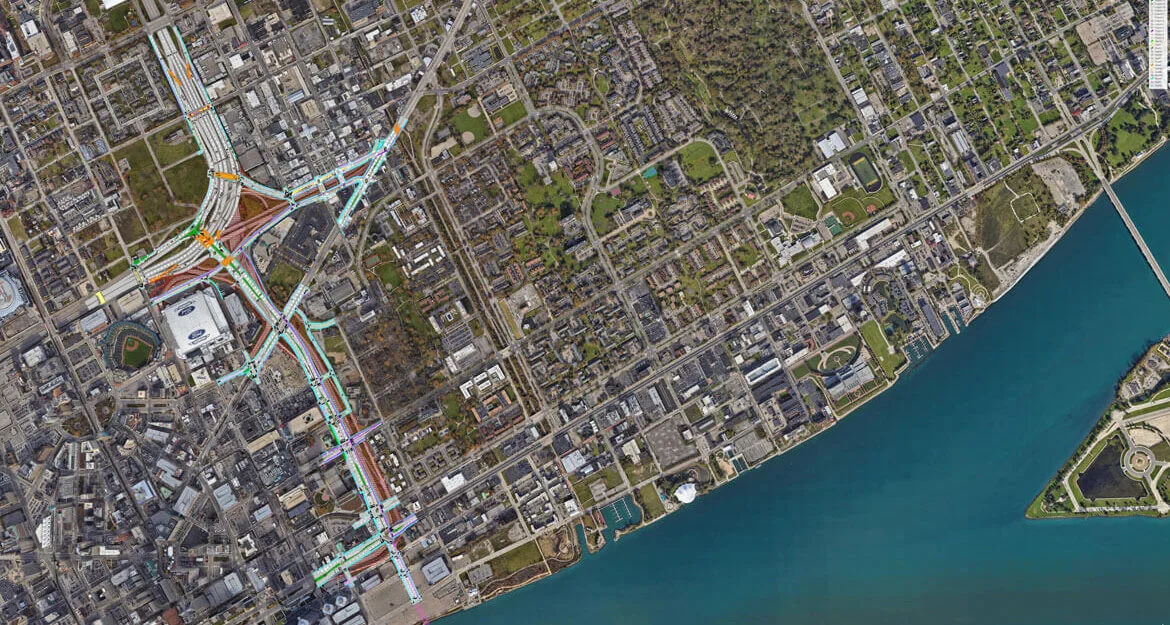
A rendering from the Michigan Department of Transportation shows I-375 being replaced with a lower-speed boulevard.
More than $100 million from President Biden’s Bipartisan Infrastructure Law will allow the Michigan Department of Transportation to replace I-375 near Detroit with a new boulevard. It’s set to help curb historic inequities and spur economic growth.
MICHIGAN—Detroiters know that there’s no way to reverse history—or to ever fully repair the damage caused after I-375’s construction effectively tore the Motor City asunder in the 1960s.
But with hundreds of millions of dollars in state and federal funding, they’ll do their best.
In 2025, the Michigan Department of Transportation aims to start construction on an ambitious plan to fully replace I-375 with a lower-speed boulevard. And according to a new report from the Center for American Progress (CAP), eliminating the highway “gash across Detroit” will go a long way in rebuilding vibrant Black neighborhoods that once stood beneath the concrete.
Among the other benefits: About $50 million in new real estate that will hit the market when the highway is removed and about 4,500 new jobs that will be supported through the project.
“There’s no correcting for what happened with urban renewal and the removal of the Black Bottom and Paradise Valley neighborhoods,” Project Manager Jon Loree said in the new report. “We want to provide opportunities for those that were affected and for those in the corridor. MDOT is a transportation agency, but we can bring a strong social equity lens to the project.”
‘More Than Just a Road Project’
The mile-long sunken highway of I-375 ferries thousands of cars daily through the heart of the Motor City. When it opened in 1964, the idea was to allow people to move in and out of the city as quickly as possible. But Detroiters—Black Detroiters in particular—felt the consequences.
Reports show that the installation of the interstate highway downtown sped up traffic. But it also displaced more than 130,000 people, shuttered hundreds of small businesses, and effectively destroyed a historic hub of Black cultural life in Detroit that once rivaled Harlem in New York.
The consequences were intentional, generational, and they continue to affect Detroiters today.
But thanks to a $105 million grant secured through President Joe Biden’s Infrastructure Investment and Jobs Act this year, the highway—after six decades—will finally be removed. In its place, crews will build a six-lane, 35-mph boulevard between I-75 and Jefferson Avenue.

Local leaders have been trying to put the plan in motion since the early aughts. The $105 million Department of Labor grant accelerated the timeline by more than two years, with the latest plans now tentatively calling for construction on the project to begin sometime in 2025. The rest of the costs of the $300 million project will also be covered by state and federal funding.
Wendy Lewis Jackson, a director at the Kresge Foundation who has been involved with the project since its first planning study in 2010, said the project must be “reparative” and collaboratively centered on historically underserved communities—like Black Detroiters.
The damage can’t be fully corrected. But it’s an opportunity to reconnect communities, she said.
“The entire city is paying attention. For Detroiters, this is more than just a road project,” Lewis Jackson said in the CAP report. “It’s imperative that a model for comprehensive approaches to equitable economic development that builds Black wealth emerges from this work and that it honors the history of the area where an entire Black neighborhood was erased.”
Historic Investments
Over the last three years, Biden has signed several major pieces of economic legislation, including the Infrastructure Investment and Jobs Act, the CHIPS and Science Act, and the Inflation Reduction Act. Together, they make up what the Biden administration calls its “Investing in America” agenda to spur economic growth, grow the middle class, and boost living standards.
The CAP report describes the legislation as the country’s “most ambitious industrial strategy” since the creation of the interstate highway system following World War II. The laws include investments to bolster manufacturing, improve wages, and accelerate a clean energy transition.

In Michigan, the legislation has spurred dozens of projects—including new battery manufacturing plants for electric vehicles, key improvements to the Soo Locks, a project to create more two-way streets in Kalamazoo, and plans to solve the I-375 problem in Detroit.
READ MORE: Transforming One-Way Streets to Ignite Downtown Foot Traffic
In Detroit, reports show that significant efforts have already been made by community members to honor the history of the area by amplifying the “voices, experiences, and perspectives” of Black residents. A project called the Black Bottom Archives is compiling records of the history.
In addition to creating about 25 acres of land for development, the I-375 replacement project is also set to create new pedestrian walkways, buffered bike lanes, and two-way roads between nearby Lafayette Park, the theater district, and the Eastern Market.
A local advisory committee will work out a plan for how the extra downtown acreage could be put to use—including reserving some space for affordable housing and allowing descendants of displaced families and businesses to get first grabs on the newly available downtown land.
By the time it’s finished, the project is also expected to help support at least 4,500 new jobs.
For the latest Michigan news, follow The ‘Gander on Twitter.
Follow Political Correspondent Kyle Kaminski here.
Support Our Cause
Thank you for taking the time to read our work. Before you go, we hope you'll consider supporting our values-driven journalism, which has always strived to make clear what's really at stake for Michiganders and our future.
Since day one, our goal here at The 'Gander has always been to empower people across the state with fact-based news and information. We believe that when people are armed with knowledge about what's happening in their local, state, and federal governments—including who is working on their behalf and who is actively trying to block efforts aimed at improving the daily lives of Michigan families—they will be inspired to become civically engaged.


VIDEO: Trump isn’t the only republican facing charges for alleged financial crimes
https://www.tiktok.com/@gandernewsroom/video/7361494909938978090 A whole lot of Michigan Republicans and lobbyists are facing criminal charges for...

VIDEO: It’s expensive to be poor in Michigan
https://www.tiktok.com/@gandernewsroom/video/7361154790300060974 Ever heard of predatory payday loans? Here’s how new laws could help protect...

Here’s everything you need to know about this month’s Mercury retrograde
Does everything in your life feel a little more chaotic than usual? Or do you feel like misunderstandings are cropping up more frequently than they...

The ’Gander wins multiple 2023 Michigan Press Association awards
MICHIGAN—The ’Gander Newsroom has earned multiple awards in the 2023 Michigan Press Association Better Newspaper Contest. The awards were announced...

Michigan Republicans ask Supreme Court to restrict medication abortion access
A lawsuit supported by Republicans could disrupt access to the most common form of abortion—even in Michigan, where reproductive rights are...





